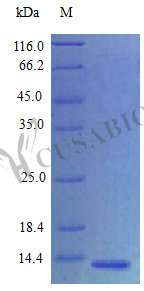Recombinant Human Amphiregulin protein (AREG) is produced in an E. coli expression system and covers the amino acid region 101-198, presented as a partial protein. This product is tag-free and exhibits a purity level exceeding 95% as determined by SDS-PAGE. The endotoxin level is maintained at less than 1.0 EU/µg, ensuring low contamination for research purposes. Biologically active, this protein achieves an ED50 of 5-10 ng/ml in a cell proliferation assay using murine Balb/c 3T3 cells.
Amphiregulin functions as a growth factor that appears to play important roles in various cellular processes, including cell proliferation and differentiation. As a member of the epidermal growth factor (EGF) family, it interacts with the epidermal growth factor receptor (EGFR) and likely contributes to tissue development and repair. What makes amphiregulin particularly interesting for researchers is its involvement in signaling pathways that may regulate cellular growth and development.
Potential Applications
Note: The applications listed below are based on what we know about this protein's biological functions, published research, and experience from experts in the field. However, we haven't fully tested all of these applications ourselves yet. We'd recommend running some preliminary tests first to make sure they work for your specific research goals.
1. Cell Proliferation and Growth Factor Studies
This recombinant human amphiregulin is confirmed to be biologically active (ED₅₀ 5-10 ng/ml in murine Balb/c 3T3 cells) and suitable for proliferation studies. However, the partial sequence (101-198aa) lacks the N-terminal prodomain, which may affect protein stability and receptor binding kinetics compared to full-length amphiregulin. The high purity (>95%) supports reliable results, but researchers should validate that proliferation kinetics match full-length amphiregulin in their specific cell models.
2. EGF Receptor Family Signaling Research
The protein is appropriate for EGFR/ErbB signaling studies, but the partial nature may alter receptor dimerization preferences or signaling amplitude. The tag-free design ensures authentic receptor engagement, but researchers should compare phosphorylation patterns (particularly ERK and AKT pathways) with full-length amphiregulin to confirm physiological signaling dynamics. The demonstrated cross-species activity suggests proper EGFR binding domain folding.
3. Antibody Development and Validation
This partial amphiregulin (101-198aa) serves as a limited antigen for antibody development. Antibodies will only recognize epitopes in the EGF-like domain and miss the N-terminal prodomain. Comprehensive antibody validation should include testing against full-length amphiregulin to ensure recognition of all functional domains. The confirmed bioactivity supports the development of function-blocking antibodies targeting the receptor-binding region.
4. Protein-Protein Interaction Studies
The biologically active amphiregulin is suitable for studying EGFR interactions, but the missing prodomain may affect interactions with regulatory proteins like ADAM proteases that cleave full-length amphiregulin. Studies focusing on core EGFR binding are well-supported, but interactions involving the prodomain should be validated with full-length protein. The tag-free design minimizes artifacts in binding assays.
5. Comparative Functional Analysis
This partial amphiregulin enables functional comparisons, but researchers should note that the ED₅₀ was determined in murine cells and may not directly reflect potency in human systems. Comparative studies with other EGF family members should account for the partial sequence, which may have different receptor affinity and signaling properties than full-length amphiregulin.
Final Recommendation & Action Plan
This recombinant human amphiregulin partial protein (101-198aa) represents the mature EGF-like domain and demonstrates good biological activity, making it suitable for EGFR-focused studies with appropriate validation of its truncated nature. Prioritize confirming that key amphiregulin functions - particularly receptor binding affinity, signaling kinetics, and proliferation effects - match full-length amphiregulin in your specific experimental systems. For cell-based assays, the 5-10 ng/ml ED₅₀ provides a reliable starting point, but optimize concentrations for each cell type as receptor expression varies. When developing antibodies, this protein is ideal for generating domain-specific reagents targeting the receptor-binding region, but supplemented with full-length antigen for comprehensive coverage. The E. coli expression produces a non-glycosylated protein, which is advantageous as the EGF-like domain is not glycosylated, but the missing prodomain remains a significant consideration for studies of amphiregulin regulation and processing. Always include proper controls and consider that the partial protein may exhibit different stability and clearance kinetics compared to full-length amphiregulin in longer-term experiments.






